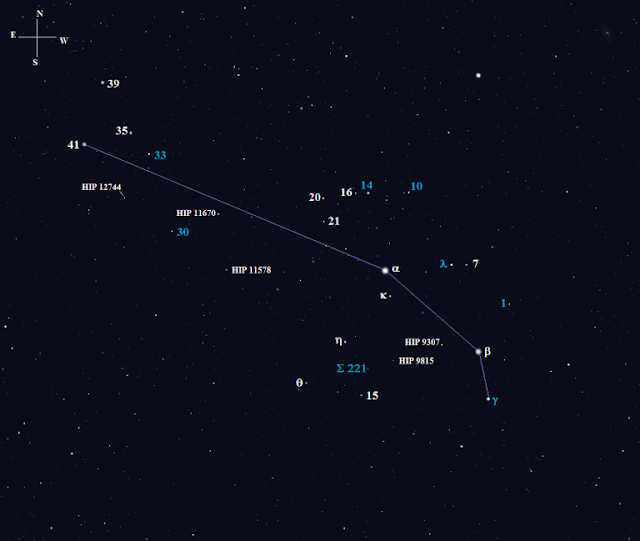Ashwini Nakshatra (Beta and gamma Arietis),
 |
| (β and γ Arietis), (0°00′ – 13°30′ Aries) |
In astronomy, the twin stars that make up the nakshatra of Ashwini are called β and γ Arietis.Ashvini is the first nakshatra (lunar mansion) in Hindu astrology having a spread from 0°-0'-0" to 13°-20', corresponding to the head of Aries, including the stars β and γ Arietis. The name aśvinī is used by Varahamihira (6th century). The older name of the asterism, found in the Atharvaveda and in Panini, was aśvayúj, "harnessing horses".
Beta Arietis is a star system and the second-brightest star in the constellation of Aries, marking the ram's second horn
Beta Arietis has an apparent visual magnitude of 2.66. Based on parallax measurements, it is located at a distance of 59.6 light-years (18.3 parsecs) from Earth. This is a spectroscopic binary star system consisting of a pair of stars orbiting around each other with a separation that can not currently be resolved with a conventional telescope. However, the pair have been resolved using the Mark III Stellar Interferometer at the Mount Wilson Observatory. This allows the orbital elements to be computed, as well as the individual masses of the two stars. The stars complete their highly elliptical orbit every 107 days.
Gamma Arietis (γ Arietis) is a binary star in the northern constellation of Aries. The two components are designated γ¹ Arietis or Gamma Arietis B and γ² Arietis or Gamma Arietis A (formally named Mesarthim, the traditional name for the Gamma Arietis system). The combined apparent visual magnitude of the two stars is 3.86, which is readily visible to the naked eye and makes this the fourth-brightest member of Aries. Based upon parallax measurements obtained during the Hipparcos mission, the distance to Gamma Arietis from the Sun is approximately 164 light-years (50 parsecs).
The double star nature of this system was discovered by Robert Hooke in 1664.The two components have an angular separation of 7.606 arcseconds,which can be resolved with a small telescope. The orbital period of the pair is greater than 5000 years.The brighter component, γ² Arietis, is a Lambda Boötis (chemically peculiar) star with a stellar classification of A1p Si and a magnitude of 4.64. It is classified as an α² CVn type variable star and its brightness varies by 0.04 magnitudes with a period of 2.61 days. The secondary, γ¹ Arietis, is a magnitude 4.58 B-type main-sequence star with a stellar classification of B9 V.
Gamma Arietis has been called "the First Star in Aries" as having been at one time the nearest visible star to the equinoctial point.
In Hindu astrology, Gamma Arietis and Beta Arietis (Sheratan) are Ashvins, the twin Rigvedic deities who act as doctors of the divine of the world.
Sources: Wikipedia
Image credit:
bestdoubles.wordpress.com/2010/12/11/lambda-%CE%BB-arietis-1-arietis-and-a-whole-new-way-of-staying-warm/













Comments
Post a Comment